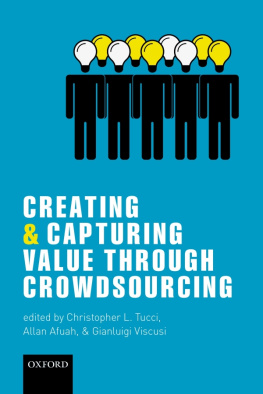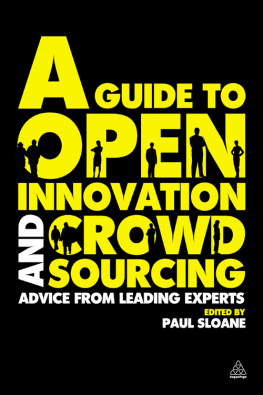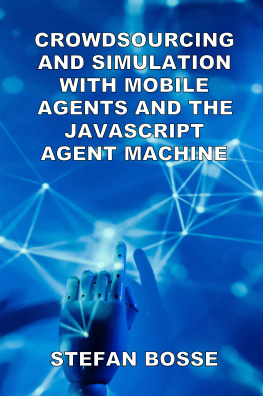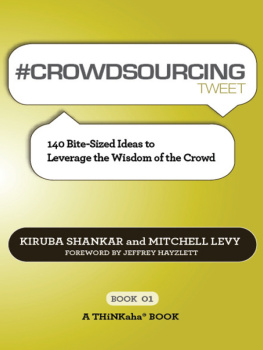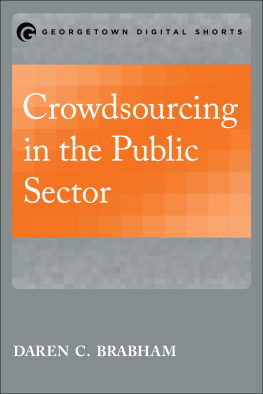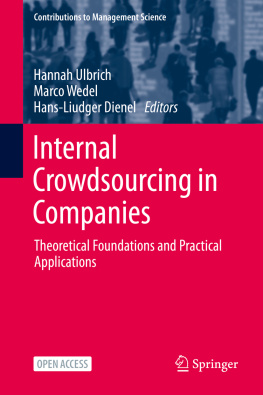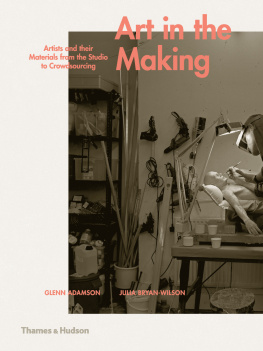Creating and Capturing Value through Crowdsourcing

Great Clarendon Street, Oxford, OX2 6DP, United Kingdom
Oxford University Press is a department of the University of Oxford. It furthers the University's objective of excellence in research, scholarship, and education by publishing worldwide. Oxford is a registered trade mark of Oxford University Press in the UK and in certain other countries
Oxford University Press 2018
The moral rights of the authors have been asserted
First Edition published in 2018
Impression: 1
All rights reserved. No part of this publication may be reproduced, stored in a retrieval system, or transmitted, in any form or by any means, without the prior permission in writing of Oxford University Press, or as expressly permitted by law, by licence or under terms agreed with the appropriate reprographics rights organization. Enquiries concerning reproduction outside the scope of the above should be sent to the Rights Department, Oxford University Press, at the address above
You must not circulate this work in any other form and you must impose this same condition on any acquirer
Published in the United States of America by Oxford University Press 198 Madison Avenue, New York, NY 10016, United States of America
British Library Cataloguing in Publication Data
Data available
Library of Congress Control Number: 2017952316
ISBN 9780198816225
ebook ISBN 9780192548207
Printed and bound by CPI Group (UK) Ltd, Croydon, CR0 4YY
Links to third party websites are provided by Oxford in good faith and for information only. Oxford disclaims any responsibility for the materials contained in any third party website referenced in this work.
Foreword to Creating and capturing value through crowdsourcing
Henry Chesbrough
Innovation has come a long way in a short period of time. Just thirty years ago, thinkers like Michael Porter of Harvard were telling innovators to invest heavily in internal R&D to use as a barrier against their competitors. The idea was that this investment would differentiate the company in the market, and that only those companies who made similar levels of investment could keep up. This R&D activity was organized inside the company, and its results shared with no one until the products that resulted from innovation went to market.
The leading companies of the day were distinguished in part by the level of their internal R&D spending. Computer makers like IBM poured their dollars into new computer hardware and software. AT&T built out its Bell Laboratories research system, perhaps the most accomplished industrial lab of its day. Auto makers such as Ford, GM, and Chrysler spent billions each year in rolling out new cars and trucks. Pharmaceutical giants such as Merck created powerful research arms that reached back into the basic sciences of biology and chemistry, and filled their product pipelines with compounds they discovered and developed inside their own four walls.
Today things are very different in most industries, not only in the US but around the world. The model of industrial innovation has moved on from this inwardly focused, vertically integrated approach that I call a Closed Innovation system. Open Innovation today prevails, as organizations make extensive use (and re-use) of external ideas and technologies in their own innovation activities, while unused or under-used ideas and technologies internally are allowed to go to the outside for others to utilize. The result is a much deeper division of innovation labor, where specialist firms contribute discoveries and innovations that connect together to form a web of innovation. Startups and small to medium-sized enterprises and even individuals play a far more significant role, while the large firms seek to attract and collaborate with these small, agile, skilled participants.
Data from the National Science Foundation on R&D spending in the US over the past thirty years bears out the extent of this shift (see ).

Figure 1. Percentage of R&D performed by companies of different sizes, 19812011
Sources: National Science Foundation, Science Resource Studies, Survey of Industrial Research Development 1999, 2001, 2003, 2006, 2008, 2011.
This chart shows that large firms with more than 25,000 employees were responsible for 70% of the industrial R&D spending done in the US in 1981. But their share of R&D spending shrank by half to 35% in 2007. In contrast, small firms with less than 1,000 employees increased their share of R&D spending from 4% to 24% during that period. Note that large firms are still important in industrial R&D because their share is still very big (35%). The amount of R&D spending in large firms increased from $21.2 billion in 1981 to $94.8 billion in 2011, a factor of 4.
However, the increase in R&D expenditures of small firms is even more impressive. Firms with less than 1,000 employees spent $64.7 billion on R&D in 2011 compared to $1.3 billion in 198150 times as much spending! Another way to look at this is smaller firm R&D spending overall has grown 10 times as fast as large company spending over these 26 years. Clearly, the world of innovation has changed.
You can see this new, deeper division of innovation labor in practice, as well as in the statistics. IBM now makes more money from its services business (where it supports the hardware and software of many other companies, including its competitors) than it does from its traditional product businesses. Cell phone manufacturers strive to attract applications developers to their platforms to boost the range and quality of services that customers can install on their phones. The pharmaceutical industry now licenses in most of its compounds in its product pipeline from external sources such as universities and young biotech firms, rather than carrying projects from the laboratory bench all the way through to market. Auto makers now rely primarily upon their suppliers and their suppliers suppliers for new innovations.
Within this overall shift toward more open innovation, crowdsourcing is also growing in importance. The fundamental insight underlying crowdsourcingwhich is shared by open innovationis that useful knowledge is widely distributed around the world. No one has a monopoly on that knowledge. Once you accept that, you must face the question of how best to access the wealth of knowledge around the globe.
Crowdsourcing is a powerful answer to that question. Done right, it taps into the knowledge, creativity, insight, and skill of the world around you. It can find solutions to previously intractable problems. It can help you predict next months sales, or next seasons fashions. It can improve the management of your supply chain. It can enhance your customers experience of your products and services. It even frequently outperforms polling in predicting the winners of elections. And often these improved outcomes can be created with surprisingly modest investments.
You will read about many crowdsourcing examples in this book, so I will confine myself here to one, the company Innocentive. Innocentive has built an online network of more than 200,000 people around the world who go to its website to consider challenges that companies have posted prizes to have solved. These problems are usually technical in nature, and quite difficult to solve, which is why leading companies that have not found answers internally have reached out to the Innocentive community for solutions.

